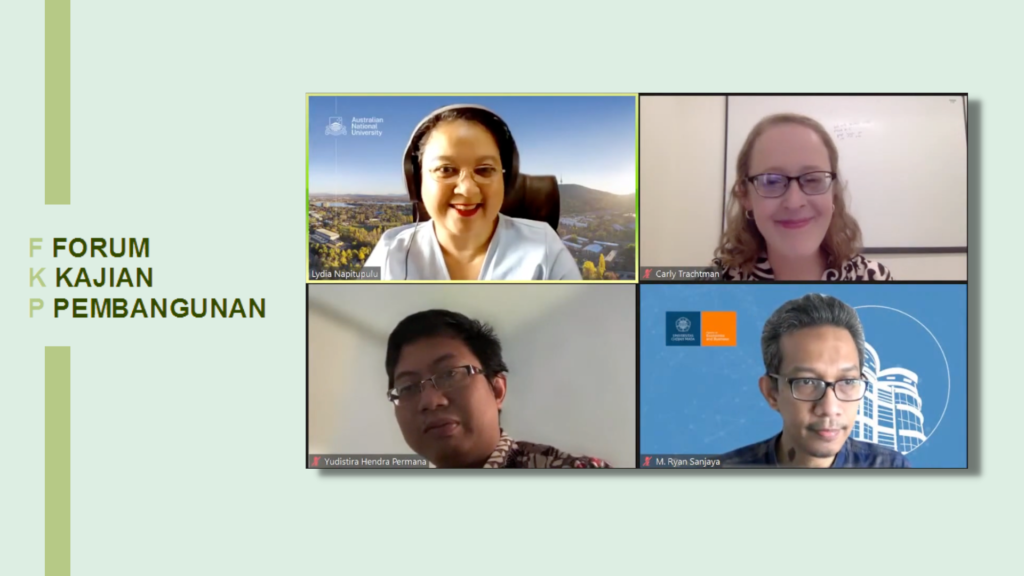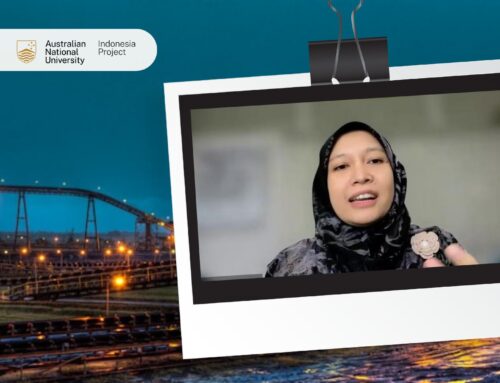FKP hosted by FEB UGM with Carly Trachtman (University of California, Berkeley). Thursday, 17 February 2022.
KEY POINTS:
- A classical motivation for using the information provided by the local community to target social benefits in developing countries is that community members may have more current, dynamic welfare information about others than a centralized program implementer. However, there is little direct evidence supporting this claim, which mostly relies on correlations between community-provided information and survey-collected welfare metrics. To understand what information community members have and use in targeting, the researchers conduct lab-in-the-field experiments and community meeting exercises in Purworejo, Central Java.
- There are three main findings of this experiment, the first is that community members have relatively little dynamic welfare information (consumption, neediness). Instead, community members seem to have more information about relatively static asset measures, and this is primarily the type of information that they use when making targeting decisions. Lastly, when community members were asked to make joint decisions at a group meeting with others, the targeting outcomes are very similar compared to the individual outcome. It suggests that joint decision-making does not seem to improve targeting.
SUMMARY
- Targeting benefits to those currently most in need is still an issue for many governments around the world. This issue is especially more challenging in developing countries. Standard approaches which estimate welfare based on easily observable and fairly static proxies (assets, demographics) may not be useful and are imperfect in general.
- One possible solution is Community-Based Targeting, an approach that asks local communities for help identifying the neediest households. A classical motivation for using the information provided by the local community to target social benefits in developing countries is that community members may have more current, dynamic welfare information about others than a centralized program implementer. It is also often a cheaper option for the government to implement, and it gives the community more agency in decision-making. Local communities are claimed to have more dynamic information about others’ welfare status than what policymakers can easily observe. However, there is little direct evidence supporting this claim, which mostly relies on correlations between community-provided information and survey-collected welfare metrics.
- To understand what information community members have and use in targeting, the researchers conduct lab-in-the-field experiments and community meeting exercises with 300 families of 10 randomly chosen rukun tetangga/RT (neighborhood) in 3 villages in Purworejo, Central Java. The setting is primarily an agricultural area (rice) and the community is socially homogeneous: Muslim, Javanese, not migrants, participate in community organizations. Also, decision-making by local communities/institutions is common in this area.
- In the experiment, respondents were shown 20 note cards with names of family heads in the RT in random order. For each, they were asked how well they knew that household. The first 8 households were well known and 2 households were less well known. Individuals were then asked to make welfare-related rankings of other families under various prompts/incentives under two key forms. The first form is a standard targeting task where individuals were asked to rank families from “poorest” to “richest”. Some number of those ranked poorest will receive an additional Rp 5,000 in the experiment. The second task is information elicitation, where individuals were asked to rank families based on a variety of different dynamic welfare proxies such as consumption expenditures, neediness, negative shocks/benefits, and more fixed proxies such as assets. In this second task, participants were given incentive/payment based on how well their ranking matches their ranking in survey data.
- In addition to the individual experiment, there were also community meeting experiments where the participants jointly list characteristics of being rich and poor and collaboratively rank all 30 families from “Poorest” to “Richest”. Random numbers ranked the poorest would get Rp 50,000. The participant-assessed welfare metrics from the experiment would then be compared to survey-assessed welfare metrics to identify what information the community has, and the participant-assessed welfare information will be compared to targeting outcomes to identify what information the community uses in targeting.
- There are three main findings of this experiment, the first is that community members have relatively little dynamic welfare information. Participants cannot report accurately about shocks faced by others when directly asked, many “don’t know” if a random family experienced shock (43%)/get COVID support (52%). Families who faced a shock are identified correctly only 13% of the time.
- Secondly, community members seem to have more information about relatively static asset measures, and this is primarily the type of information that they use when making targeting decisions. Community welfare information seems to mainly reflect more static asset wealth, there is no evidence community members observe others’ shocks/welfare changes over time. Assets are most highly correlated with targeting rankings, suggesting the use of assets in targeting by the community. In addition, participants also overwhelmingly justify their decisions with land ownership info. Dynamic information plays a smaller role, likely because community members simply do not have dynamic information about others.
- Lastly, when community members were asked to make joint decisions at a group meeting with others, the targeting outcomes are very similar compared to the individual outcome. Going from individual to community-formed targeting rankings doesn’t generally increase correlation with survey benchmarks, which suggests that joint decision-making does not seem to improve targeting.
- In conclusion, Community Based Targeting does not have an advantage over standard methods in identifying “acute distress”. However, CBT is still quite useful in capturing longer-term poverty and gives community agency in local decision-making. For future research, it is important to try to understand the local information environment in different settings throughout the developing world because cultural information-sharing norms and local social structures likely matter.
This paper can be downloaded from this link.





